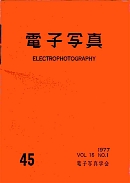Sensitization of polyvinylcarbazole with compounds having electron accepting properties has been investigated. Light decay characteristics both for negative and positive charge and the photocurrent as well as photovoltaic effect were studied with monochromatized light. Acceptors used are I-VI (cf. formulae).
Polymer film is prepared on a copper plate as explalned in Fig. 1. Spectral intensity distribution of the xenon light source is shown in Fig. 2. Experimental arrangement for the decay experiment is shown in Fig. 3. Photocurrent through the film is measured with a cell like Fig. 4
For decay experiment, slit width was 20mμ. Decay constant was calculated by an equation
V=
V0e-αt1/2 (cf. preceeding paper), and corrected for the light intensities.
As show in Fig. 5, decay constant of polyvinylcarbazole is very large when charged positive, having some sensitivity even in visible region where almost no light absorption is observed (Fig. 6) . The result suggests that the major carrier in polyvinylcarbazole is hole.
Spectral response of the photocurrennt is shown in Fig. 7. Photocurrent obtained when positive electrode is illuminated being larger, the result suggests again that hole is the dominant carrier. Spectral response of the photovoltaic effect is shown in Fig. 8. As the sign of the current is taken as explained in the figure, the result is understood by assuming higher mobility of positive carrier.
Decay constant of polyvinylcarbazole sensitized with varying amount of chloranil is shown in Fig. 9. From this result the amount of various acceptors added to polylvinylcarbazole as sensitizer is settled to 1%. Spectral response of the decay constant with different acceptors is shown in Fig. 10. When charged negative, 3-7 fold increase in α is observed by sensitization, showing considerable sensitivity also in visible region. When charged positive, the sensitivity of polyvinylcarbazole being very large, the sensitization is restricted in 1-2 fold increase.
Spectral response of photocurrent of polyvinylcarbazole with compound I (TCNQ) is shown in Fig. 11. The current is larger when positive electrode is exposed. Considerable response in visible region is explained by charge transfer band of polyvinylcarbazole TCNQ complex (Fig. 12). Photovoltaic effect observed with the same system is shown in Fig. 13.
All these result are reasonably explained by assuming that the major carrier of sensitized polyvinylcarbazole is hole.
抄録全体を表示
